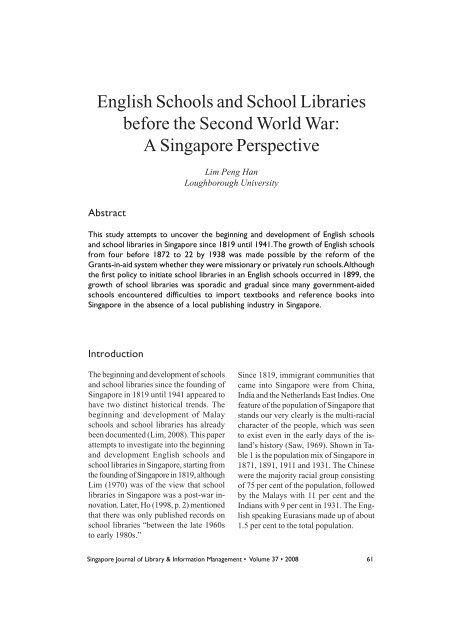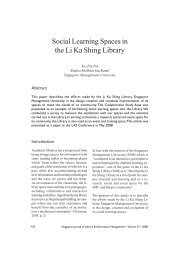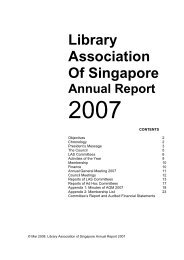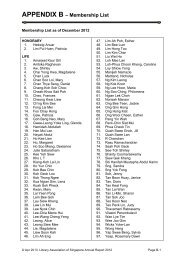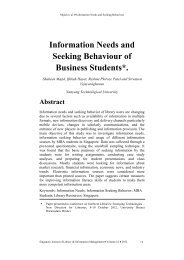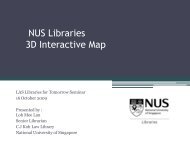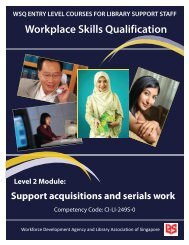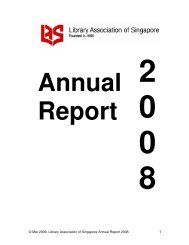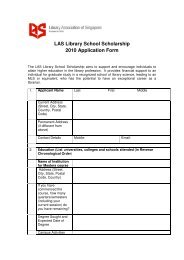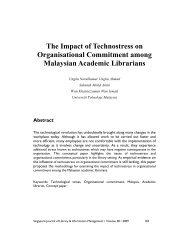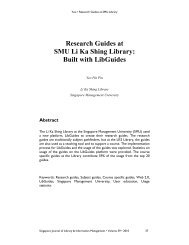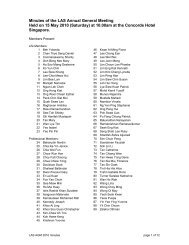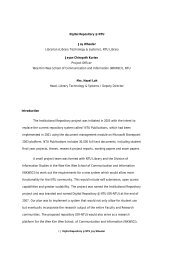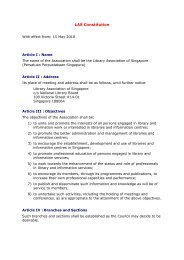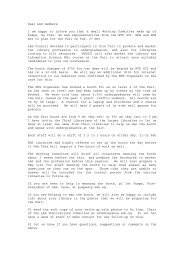English Schools and School - Library Association of Singapore
English Schools and School - Library Association of Singapore
English Schools and School - Library Association of Singapore
Create successful ePaper yourself
Turn your PDF publications into a flip-book with our unique Google optimized e-Paper software.
<strong>English</strong> <strong><strong>School</strong>s</strong> <strong>and</strong> <strong>School</strong> Libraries<br />
before the Second World War:<br />
A <strong>Singapore</strong> Perspective<br />
Abstract<br />
Lim Peng Han<br />
Loughborough University<br />
This study attempts to uncover the beginning <strong>and</strong> development <strong>of</strong> <strong>English</strong> schools<br />
<strong>and</strong> school libraries in <strong>Singapore</strong> since 1819 until 1941. The growth <strong>of</strong> <strong>English</strong> schools<br />
from four before 1872 to 22 by 1938 was made possible by the reform <strong>of</strong> the<br />
Grants-in-aid system whether they were missionary or privately run schools. Although<br />
the first policy to initiate school libraries in an <strong>English</strong> schools occurred in 1899, the<br />
growth <strong>of</strong> school libraries was sporadic <strong>and</strong> gradual since many government-aided<br />
schools encountered difficulties to import textbooks <strong>and</strong> reference books into<br />
<strong>Singapore</strong> in the absence <strong>of</strong> a local publishing industry in <strong>Singapore</strong>.<br />
Introduction<br />
The beginning <strong>and</strong> development <strong>of</strong> schools<br />
<strong>and</strong> school libraries since the founding <strong>of</strong><br />
<strong>Singapore</strong> in 1819 until 1941 appeared to<br />
have two distinct historical trends. The<br />
beginning <strong>and</strong> development <strong>of</strong> Malay<br />
schools <strong>and</strong> school libraries has already<br />
been documented (Lim, 2008). This paper<br />
attempts to investigate into the beginning<br />
<strong>and</strong> development <strong>English</strong> schools <strong>and</strong><br />
school libraries in <strong>Singapore</strong>, starting from<br />
the founding <strong>of</strong> <strong>Singapore</strong> in 1819, although<br />
Lim (1970) was <strong>of</strong> the view that school<br />
libraries in <strong>Singapore</strong> was a post-war innovation.<br />
Later, Ho (1998, p. 2) mentioned<br />
that there was only published records on<br />
school libraries “between the late 1960s<br />
to early 1980s.”<br />
Since 1819, immigrant communities that<br />
came into <strong>Singapore</strong> were from China,<br />
India <strong>and</strong> the Netherl<strong>and</strong>s East Indies. One<br />
feature <strong>of</strong> the population <strong>of</strong> <strong>Singapore</strong> that<br />
st<strong>and</strong>s our very clearly is the multi-racial<br />
character <strong>of</strong> the people, which was seen<br />
to exist even in the early days <strong>of</strong> the isl<strong>and</strong>’s<br />
history (Saw, 1969). Shown in Table<br />
1 is the population mix <strong>of</strong> <strong>Singapore</strong> in<br />
1871, 1891, 1911 <strong>and</strong> 1931. The Chinese<br />
were the majority racial group consisting<br />
<strong>of</strong> 75 per cent <strong>of</strong> the population, followed<br />
by the Malays with 11 per cent <strong>and</strong> the<br />
Indians with 9 per cent in 1931. The <strong>English</strong><br />
speaking Eurasians made up <strong>of</strong> about<br />
1.5 per cent to the total population.<br />
<strong>Singapore</strong> Journal <strong>of</strong> <strong>Library</strong> & Information Management • Volume 37 • 2008 61
First Education Policy for the<br />
New Settlement<br />
Lim • <strong>English</strong> <strong><strong>School</strong>s</strong> & <strong>School</strong> Libraries before WWII<br />
Table 1: Population <strong>of</strong> <strong>Singapore</strong> by race<br />
YearMalays Chinese Indians Eurasians Europeans Others Total<br />
1871° 26, 148<br />
54, 572<br />
11, 610<br />
2, 164<br />
1, 946<br />
671 97,<br />
111<br />
2 7.<br />
0%<br />
5 6.<br />
2%<br />
1 2.<br />
0%<br />
2 . 2%<br />
2 . 0%<br />
0 . 6%<br />
100%<br />
1891¹ 35, 992<br />
121, 908<br />
16, 035<br />
3, 589<br />
5, 254<br />
1, 776<br />
184,<br />
554<br />
1 9.<br />
5%<br />
6 6.<br />
0%<br />
8 . 7%<br />
2 . 0%<br />
2 . 8%<br />
1 . 0%<br />
100%<br />
1911² 41, 806<br />
219, 577<br />
27, 755<br />
4, 671<br />
5, 711<br />
3, 660<br />
303,<br />
321<br />
1 3.<br />
7%<br />
7 2.<br />
3%<br />
9 . 5%<br />
1 . 5%<br />
1 . 8%<br />
1 . 2%<br />
100%<br />
1931³ 65, 014<br />
418, 640<br />
50, 811<br />
6, 903<br />
8, 082<br />
8, 275<br />
557,<br />
745<br />
1 1.<br />
6%<br />
7 5.<br />
1%<br />
9 . 1%<br />
1 . 2%<br />
1 . 5%<br />
1 . 5%<br />
100%<br />
Sources: °MacNair, Waller & Knight, 1871, p. 7; ¹Merewether, 1892, p. 47; ²Marriott, 1911, p.<br />
360; ³Vliel<strong>and</strong>, 1932, p. 120-121.<br />
Education was recognized by Raffles as<br />
one <strong>of</strong> the first needs <strong>of</strong> his new settlement<br />
(Neilson, n.d.). In 1819, Raffles<br />
wrote in his minutes on shaping his education<br />
policy:<br />
1. To educate the sons <strong>of</strong> higher order <strong>of</strong><br />
natives <strong>and</strong> others<br />
2. To afford the means <strong>of</strong> instruction in<br />
the native languages to such <strong>of</strong> the Company’s<br />
servants <strong>and</strong> others as may desire<br />
it<br />
3. To collect the scattered literature <strong>and</strong><br />
traditions <strong>of</strong> the country, with<br />
whatevernmay illustrate their laws <strong>and</strong><br />
customs <strong>and</strong> to publish <strong>and</strong> circulate in<br />
a correct form the most important <strong>of</strong><br />
these, with such other works as may<br />
be calculated to raise the character <strong>of</strong><br />
the institution <strong>and</strong> to be useful or instructive<br />
to the people (Raffles, 1991a, p.<br />
33; Raffles, 1991b, p. 79).<br />
As a follow-up to Raffles’ education proposed<br />
plans a meeting <strong>of</strong> principal inhabitants<br />
<strong>of</strong> <strong>Singapore</strong> was held at Farquhar’s<br />
residency, on 1 April 1823 (Philips,<br />
1908).The modified proposed <strong>Singapore</strong><br />
Institution shall consist <strong>of</strong> three departments.<br />
Raffles suggested the advantage<br />
<strong>and</strong> the necessity <strong>of</strong> forming an institution<br />
in the nature <strong>of</strong> a college embracing the<br />
following objectives:<br />
1. A scientific department for the common<br />
advantage <strong>of</strong> the several Colleges that<br />
may be established<br />
2. A literary <strong>and</strong> moral department for the<br />
Chinese, which the Anglo-Chinese College<br />
affords<br />
3. A literary <strong>and</strong> moral department for the<br />
Siamese, Malay, &c., which will be provided<br />
for by the Malayan College (Raffles,<br />
1991b, p. 75)<br />
A proposed plan <strong>of</strong> the building drawn by<br />
Lieutenant Jackson was approved <strong>and</strong><br />
plans were made to purchase printing<br />
presses with “<strong>English</strong>, Malayan, <strong>and</strong><br />
6 2 <strong>Singapore</strong> Journal <strong>of</strong> <strong>Library</strong> & Information Management • Volume 37 • 2008
Lim • <strong>English</strong> <strong><strong>School</strong>s</strong> & <strong>School</strong> Libraries before WWII<br />
Siamese founts <strong>of</strong> types” on the account<br />
<strong>of</strong> the Institution; “<strong>and</strong> also to employ, on<br />
the account <strong>of</strong> the Institution”, a printer.<br />
LMS missionary Samuel Milton will take<br />
charge <strong>of</strong> the presses <strong>and</strong> superintend the<br />
printing. “Mr. Maxwell, as Secretary to the<br />
Institution, is requested to take charge <strong>of</strong><br />
the <strong>Library</strong> <strong>and</strong> Museum <strong>of</strong> the Institution,<br />
until suitable buildings may be erected,<br />
<strong>and</strong> to act as Librarian”. (Raffles 1991b,<br />
p.84)<br />
The First Resident <strong>of</strong> <strong>Singapore</strong> was Colonel<br />
William Farquhar (1819-1823) <strong>and</strong> the<br />
Second Resident was John Crawfurd<br />
(1823-1826) (Nunn, 1927). On 7 February<br />
1826, Resident Crawfurd, reported to<br />
Bengal (Philips, 1908) that “the native inhabitants<br />
<strong>of</strong> <strong>Singapore</strong> have not yet attained<br />
that state <strong>of</strong> civilization <strong>and</strong> knowledge<br />
which would qualify them to derive<br />
advantage from the enlarged system <strong>of</strong><br />
education held up by the <strong>Singapore</strong> Institution<br />
<strong>and</strong> that to prosecute under present<br />
circumstances that establishment on the<br />
footing originally contemplated would be<br />
to incur heavy expense without any prospect<br />
<strong>of</strong> corresponding <strong>and</strong> adequate benefit”<br />
(Chelliah, 1947, pp. 19-20). Raffles<br />
left for Engl<strong>and</strong> in 1824 <strong>and</strong> passed away<br />
on 5 July 1826 (Sweet, 1993).<br />
On 5 January 1827, the trustees <strong>of</strong> the <strong>Singapore</strong><br />
Institution were informed that the<br />
Government subscription was to be appropriated<br />
solely to the establishment <strong>of</strong> elementary<br />
schools for the natives. For many<br />
years the monthly allowance was withheld,<br />
<strong>and</strong>, when repeated applications were<br />
made, it was reduced for a time to 100<br />
dollars, later raised to 200 dollars, <strong>and</strong> never<br />
paid in full. Funds being exhausted, the<br />
building ill-constructed from the outset, was<br />
left in an unfinished state <strong>and</strong> unused. In<br />
1832 a local paper referred to it as “a ruin”<br />
<strong>and</strong> “an eyesore to the inhabitants” (Philips,<br />
1908, pp. 269-270).<br />
<strong>Singapore</strong>’s political links with Penang <strong>and</strong><br />
Malacca began with the amalgamation <strong>of</strong><br />
the three settlements to form the Straits<br />
Settlements in 1826, under one government,<br />
consisting <strong>of</strong> a Governor, with one<br />
Resident Councillor in each station, but still<br />
continued an Indian Presidency (Braddell,<br />
1921). In 1832, the seat <strong>of</strong> government <strong>of</strong><br />
the Straits Settlements was transferred<br />
from Penang to <strong>Singapore</strong> (McKerron,<br />
1948).<br />
First <strong>English</strong> <strong>School</strong> <strong>and</strong> First<br />
<strong>School</strong> <strong>Library</strong><br />
This lack <strong>of</strong> a school <strong>of</strong> any st<strong>and</strong>ing<br />
moved the new Chaplain in 1833 to apply<br />
to the Government for a grant to establish<br />
a free school. A place was given to him<br />
near the foot <strong>of</strong> Fort Canning, by High<br />
Street (Bazell, 1991). The Chaplain, Mr<br />
Darrah, proposed to establish elementary<br />
schools in different places with native<br />
masters, with a central school at which<br />
the descendents <strong>of</strong> Europeans could attend,<br />
with some <strong>of</strong> the more advanced<br />
boys from the minor schools. The school<br />
was opened on 1 August 1834. The school<br />
had 32 boys in the <strong>English</strong> classes, 18 boys<br />
in the Tamil classes <strong>and</strong> 12 in the Chinese<br />
(Buckley, 1902).<br />
When the building fell into disrepair, the<br />
Committee thought <strong>of</strong> applying for the use<br />
<strong>of</strong> the buildings <strong>of</strong> the neglected Raffles<br />
Institution. The formal application was<br />
made on 15 September 1837. Meanwhile<br />
on 1 January 1836, a meeting <strong>of</strong> subscribers<br />
to the monument to be erected to the<br />
memory <strong>of</strong> Raffles decided that they<br />
<strong>Singapore</strong> Journal <strong>of</strong> <strong>Library</strong> & Information Management • Volume 37 • 2008 63
Lim • <strong>English</strong> <strong><strong>School</strong>s</strong> & <strong>School</strong> Libraries before WWII<br />
would best perpetuate the remembrance<br />
<strong>of</strong> the eminent services rendered to the<br />
Settlement by completing the Institution<br />
founded by him for the purposes <strong>of</strong> education.<br />
Repairs were started, <strong>and</strong> in December<br />
1837 the <strong>Singapore</strong> Free <strong>School</strong><br />
was removed from High Street to the Institution,<br />
then for the first time used for its<br />
original purpose (Bazell, 1921).<br />
The earliest accessible record <strong>of</strong> the proposed<br />
<strong>Singapore</strong> Institution <strong>and</strong> its library<br />
<strong>and</strong> Museum was in the third annual report<br />
(1836-37) <strong>of</strong> the <strong>Singapore</strong> Free<br />
<strong>School</strong> (Hanitsch, 1921). There was a<br />
short list <strong>of</strong> books presented to the school,<br />
with the remark: “The few books which<br />
form the <strong>School</strong> <strong>Library</strong> are in constant<br />
circulation among the boys <strong>and</strong> their<br />
friends.” It was reported that “funds will<br />
be required to furnish a library <strong>and</strong> museum,<br />
in which books given to the institution<br />
<strong>and</strong> all such specimens <strong>of</strong> the natural<br />
history <strong>of</strong> these regions as can be collected<br />
shall be kept” (<strong>Singapore</strong> Free <strong>School</strong>,1837,<br />
pp. 8-9). This is the first known record <strong>of</strong><br />
a school library for the <strong>English</strong> classes <strong>of</strong><br />
the <strong>Singapore</strong> Free <strong>School</strong>. In 1835, the<br />
<strong>Singapore</strong> Free <strong>School</strong> was known as the<br />
<strong>Singapore</strong> Institution Free <strong>School</strong>.<br />
In the fourth annual report (1837-38) <strong>of</strong><br />
the <strong>Singapore</strong> Institution Free <strong>School</strong>: “The<br />
number <strong>of</strong> volumes already in the <strong>Library</strong><br />
is 392. The principle upon which the <strong>Library</strong><br />
is founded is as follows: Free admission<br />
is given to anyone. All subscribers<br />
<strong>and</strong> donors to the Institution, <strong>and</strong> the teachers<br />
<strong>and</strong> scholars therein, are entitled to<br />
remove books from the library for perusal,<br />
<strong>and</strong> any other party may acquire the same<br />
right on a monthly payment to the Librarian<br />
for 25 cents” (<strong>Singapore</strong> Institution<br />
Free <strong>School</strong>, 1838, p. 13).<br />
Except for the annual reports <strong>of</strong> the <strong>Singapore</strong><br />
Institution Free <strong>School</strong> there were<br />
no annual review produced on the Straits<br />
Settlements until 1855/1856, although it<br />
was formed in 1826 (Jarman, 1998). Officers<br />
<strong>of</strong> the Indian Civil Service, the elite<br />
corps <strong>of</strong> Britain’s overseas cadres, were<br />
never interested in the straits, <strong>and</strong>, from<br />
1830 to the end <strong>of</strong> company rule in 1867,<br />
recruits came mainly from the Indian Army,<br />
with occasional entrants being nominated<br />
by company directors from business firms<br />
or from the clerical ranks in India. General<br />
speaking, the straits service in this<br />
period stood at the bottom <strong>of</strong> the imperial<br />
ladder, reflecting the stepchild status <strong>of</strong> the<br />
settlements it worked in. For Governors,<br />
too, the straits were seen as the end <strong>of</strong> the<br />
line, a place with no future. That reputation<br />
was to haunt the colony for the rest <strong>of</strong><br />
the century (Heussler, 1981).<br />
First <strong>School</strong> Reform<br />
On 1 April 1867, the Straits Settlements<br />
were transferred from the control <strong>of</strong> the<br />
Indian Government to that <strong>of</strong> the Secretary<br />
<strong>of</strong> State for the Colonies in London<br />
(Jarman, 1998). In 1870, Sir Harry Ord,<br />
appointed a Select Committee, under the<br />
Chairmanship <strong>of</strong> Colonal R. Wolley, ‘to<br />
enquire into the State <strong>of</strong> Education in the<br />
Colony’. The Committee recommended:<br />
1. To appoint an Inspector <strong>of</strong> <strong><strong>School</strong>s</strong>,<br />
Straits Settlements.<br />
2. To reform the existing Grants-in-aid<br />
system, which mainly applied to <strong>English</strong><br />
schools whether they be missionary<br />
or privately run.<br />
3. To greatly extend <strong>and</strong> improve vernacular<br />
education, especially Malay vernacular<br />
education.<br />
6 4 <strong>Singapore</strong> Journal <strong>of</strong> <strong>Library</strong> & Information Management • Volume 37 • 2008
Lim • <strong>English</strong> <strong><strong>School</strong>s</strong> & <strong>School</strong> Libraries before WWII<br />
In 1872, Mr A. M. Skinner, a young British<br />
<strong>of</strong>ficial <strong>of</strong> the Penang Administration<br />
was appointed to the newly created post<br />
<strong>of</strong> Inspector <strong>of</strong> <strong><strong>School</strong>s</strong>, Straits Settlements.<br />
Skinner held the post until 1879<br />
(Wong & Gwee, 1980). He devoted his<br />
main energies to the establishment <strong>of</strong><br />
Malay schools <strong>and</strong> by the foundation <strong>of</strong> a<br />
Malay College – a training college for<br />
Malay schoolmasters – in 1878<br />
(Cheeseman, 1955). Malay vernacular<br />
education is free. <strong>English</strong> education as a<br />
rule is paid for. The Government <strong>English</strong><br />
schools <strong>and</strong> all the Malay vernacular<br />
schools are directly controlled by the Education<br />
Department (Elcum, 1968).<br />
Government-aided <strong>English</strong><br />
Boys’ <strong><strong>School</strong>s</strong> in <strong>Singapore</strong><br />
Raffles Institution began as a Protestant<br />
<strong>English</strong> boys’ school in 1834 (Bazell, 1921).<br />
St Joseph’s Institution is a Roman Catholic<br />
educational establishment opened in a<br />
disused church in 1848. It became a grantin-aid<br />
school in 1863 (Bazell, 1921). A<br />
mixed school was opened by Father Jose<br />
Pedro Santana da Cunha in 1879, in a small<br />
house in Middle Road. In 1893, the school<br />
became known as St Anthony’s Boy’s<br />
<strong>School</strong> for the boys <strong>and</strong> St Anthony Girls’<br />
<strong>School</strong> remained for the girls (Teixeira<br />
1963). Our Lady <strong>of</strong> Lourdes Anglo-Tamil<br />
<strong>School</strong> was founded in 1885 for Tamil boys.<br />
It became an aided school in 1886 <strong>and</strong><br />
ceased to exist by 1904 (Bazell, 1921). St<br />
Andrew’s <strong>School</strong> was founded in 1872 in<br />
connection with the St Andrew’s Church<br />
Mission. In 1872, it became a gr<strong>and</strong>-in-aid<br />
school (Kovilpillai, 1963). The Eastern<br />
<strong>School</strong> was founded in 1891, for the purpose<br />
<strong>of</strong> teaching Chinese boys <strong>English</strong>, <strong>and</strong><br />
was conducted by Eurasians under an advisory<br />
committee <strong>of</strong> Chinese. In 1895, Rev.<br />
A. Lamont took it over in 1895, on behalf<br />
<strong>of</strong> the Presbyterian Church. The school<br />
was closed in 1902 (Bazell, 1921). On 1<br />
March 1886, Rev. W. F. Oldham <strong>of</strong> the<br />
Methodist Episcopal Church opened a<br />
school at No. 70 Amoy Street. It became<br />
an aided school in 1887 (Bazell, 1921). The<br />
American Mission Anglo-Tamil <strong>School</strong> was<br />
opened for boys in 1889. It became an<br />
aided school in 1890. In 1913, the school<br />
became Serangoon <strong>English</strong> <strong>School</strong>. There<br />
was also an aided school at Gaylang belonging<br />
to the mission (Bazell, 1921).<br />
A free school was opened in Havelock<br />
Road by Cheang Jim Hean, the son <strong>of</strong><br />
Cheang Hong Lim, <strong>and</strong> received a Government<br />
Grant in 1893. Upon the death <strong>of</strong><br />
its founder 1901 was closed suddenly, without<br />
notice to its teachers <strong>and</strong> pupils (Bazell,<br />
1921). See Table 2 for a list <strong>of</strong> nineteenth<br />
century government-aided boys’ schools<br />
<strong>and</strong> enrolment <strong>of</strong> each school by race.<br />
Government <strong>English</strong> Boys’<br />
<strong><strong>School</strong>s</strong> in <strong>Singapore</strong><br />
In dealing with the teaching <strong>of</strong> <strong>English</strong> the<br />
Government was greatly helped by the<br />
fact that other schools had done the pioneer<br />
work. The policy adopted was to afford<br />
the various nationalities the opportunity<br />
<strong>of</strong> learning elementary <strong>English</strong> through<br />
their own language. The first two schools<br />
erected in 1874, at Cross Street <strong>and</strong><br />
Kampong Glam. (Bazell, 1921). In 1906,<br />
a new building was erected at Outram<br />
Road <strong>and</strong> the Cross Street <strong>School</strong> was<br />
known as Outram Road <strong>School</strong> (Bazell,<br />
1921).<br />
<strong>Singapore</strong> Journal <strong>of</strong> <strong>Library</strong> & Information Management • Volume 37 • 2008 65
Government-aided<br />
<strong><strong>School</strong>s</strong><br />
Protestan<br />
t<br />
Lim • <strong>English</strong> <strong><strong>School</strong>s</strong> & <strong>School</strong> Libraries before WWII<br />
Table 2: Types <strong>of</strong> <strong>English</strong> <strong><strong>School</strong>s</strong> in <strong>Singapore</strong> in 1899<br />
Europeans<br />
<strong>and</strong><br />
Eurasians<br />
ChineseMalay Indians<br />
<strong>and</strong><br />
other<br />
Asiatics<br />
6 6 <strong>Singapore</strong> Journal <strong>of</strong> <strong>Library</strong> & Information Management • Volume 37 • 2008<br />
Total<br />
1 . RafflesInstitution( 1823)<br />
96 209 15 12 332<br />
Presbyte<br />
rian<br />
2 . Eastern<strong>School</strong>( 1891)<br />
1 146 - - 147<br />
Church<br />
<strong>of</strong><br />
Engl<strong>and</strong><br />
3 . StAndrew's<strong>School</strong>( 1871)<br />
2 92 1 - 95<br />
Roman<br />
Catholic<br />
4 . StJoseph'sInstitution( 1852)<br />
171 180 - 14 365<br />
5 . StAnthony'sBoys'<strong>School</strong>( 1886)<br />
77 46 - 14<br />
6 . OurLady<strong>of</strong>LourdesAnglo-Tamil<strong>School</strong>( 1885)<br />
- 6 - 7 13<br />
Methodis<br />
t Episcop<br />
al<br />
7 . Anglo-Chinese<strong>School</strong>( 1886)<br />
81 233 6 41 361<br />
8 . AmericanMissionAnglo-Tamil<strong>School</strong>( 1889)<br />
3 - - 18 21<br />
9. GaylangMission<strong>School</strong> 12 - - 12<br />
Undenominati<br />
onal<br />
1 0.<br />
Anglo-ChineseFree <strong>School</strong><br />
( 1885)<br />
- 153 - - -<br />
1 1.<br />
CheangJimHean'sFree <strong>School</strong><br />
( 1893)<br />
- 64 -<br />
Government<br />
<strong><strong>School</strong>s</strong><br />
4311, 141<br />
22 106 1,<br />
700<br />
2 5.<br />
4%<br />
6 7.<br />
1%<br />
1 . 3%<br />
6 . 2%<br />
100%<br />
1 2.<br />
CrossStreet<strong>School</strong>( 1874)<br />
3 181 4 14 212<br />
1 3.<br />
VictoriaBridge<strong>School</strong>( 1874)<br />
61 12 73<br />
14. KampongGlamChineseBranch<strong>School</strong> - 44 44<br />
Source: Wilkinson, 1900, p. 143<br />
3 235 65 26 329<br />
1 % 7 1%<br />
2 0%<br />
8 % 100%
Lim • <strong>English</strong> <strong><strong>School</strong>s</strong> & <strong>School</strong> Libraries before WWII<br />
The Kampong Glam Malay Branch <strong>School</strong><br />
was established in 1876 (Murray, 1971)<br />
as a ‘feeder’ school to Raffles Institution<br />
(Doraisamy, 1969). In 1897, the Kampong<br />
Glam Malay Branch <strong>School</strong> <strong>and</strong> the<br />
Kampong Glam Malay <strong>School</strong>, “known as<br />
the Kampong Glam <strong>English</strong> Class” were<br />
combined into one school, Victoria Bridge<br />
<strong>School</strong>, in a new building erected close to<br />
Victoria Bridge (Elcum, 1898, p. 210). The<br />
Victoria Bridge <strong>School</strong> functioned as “a<br />
separate <strong>and</strong> entirely <strong>English</strong> school<br />
(Wilkinson, 1899, p. 87). See Table 2 for a<br />
list <strong>of</strong> government boys’ schools <strong>and</strong> enrolment<br />
<strong>of</strong> each school by race.<br />
Government-aided <strong>English</strong><br />
Girls’ <strong><strong>School</strong>s</strong> in <strong>Singapore</strong><br />
The Raffles Girls’ <strong>School</strong> was opened in<br />
the Institution buildings on 1844, with 11<br />
Table 3: Types <strong>of</strong> <strong>English</strong> Girls’ <strong><strong>School</strong>s</strong> in <strong>Singapore</strong> in 1899<br />
Governme<br />
nt-aided<br />
Girls'<br />
<strong>School</strong><br />
Protestan<br />
t<br />
Europeans<br />
<strong>and</strong><br />
Eurasians<br />
pupils. In 1877, the school was moved to<br />
Beach Road. The Convent <strong>School</strong> was first<br />
opened in 1842 with one class attended by<br />
European <strong>and</strong> Eurasian girls. It became<br />
an aided school in 1881 (Bazell, 1921). The<br />
St Anthony’s Girls’ <strong>School</strong> was opened in<br />
1879, in a small house in Middle Road. The<br />
girls’ were chiefly Malacca Portuguese<br />
(Bazell, 1921). In 1887, the Methodist Mission<br />
Anglo-Tamil Girls’ <strong>School</strong> meant for<br />
Tamils was set up at a house in Short<br />
Street. It soon attracted children <strong>of</strong> all<br />
races, <strong>and</strong> its name was changed to the<br />
American Mission Girls’ <strong>School</strong> (Ho,<br />
1964). The Methodist Mission started a<br />
small school for girls in the Telok Ayer district<br />
in 1888. In 1912, a new school was<br />
opened as the Fairfield Chinese Girls’<br />
<strong>School</strong> (Ho, 1964). See Table 3 for a list<br />
<strong>of</strong> nineteenth century government-aided<br />
girls’ schools <strong>and</strong> enrolment <strong>of</strong> each school<br />
by race.<br />
ChineseMalay Indians<br />
<strong>and</strong><br />
other<br />
Asiatics<br />
1 . RafflesGirls'<strong>School</strong>( 1844)<br />
135 1 - -<br />
Roman<br />
Catholic<br />
2 . Convent<strong>School</strong>( 1854)<br />
135 15 - 5<br />
3 . StAnthony'sGirls'<strong>School</strong>( 1879)<br />
79 2 - -<br />
Methodis<br />
t Episcop<br />
al<br />
4 . AmericanMissionGirls'<strong>School</strong>( 1887)<br />
34 14 - 10<br />
5.<br />
American<br />
Mission<br />
Chinese<br />
Girls'<br />
<strong>School</strong><br />
or<br />
Fairfield<br />
Chinese<br />
Girls'<br />
<strong>School</strong><br />
( 1888)<br />
Source: Wilkinson, 1900, p. 143.<br />
<strong>Singapore</strong> Journal <strong>of</strong> <strong>Library</strong> & Information Management • Volume 37 • 2008 67<br />
7<br />
-<br />
Total<br />
38339 - 15 437<br />
8 8%<br />
9% - 3%
Initiation <strong>of</strong> the Cambridge<br />
Local Examinations<br />
Lim • <strong>English</strong> <strong><strong>School</strong>s</strong> & <strong>School</strong> Libraries before WWII<br />
In 1891, arrangements were made with<br />
the University <strong>of</strong> Cambridge for the introduction<br />
<strong>of</strong> the Cambridge Local Examinations.<br />
A Local Committee was formed, with<br />
a Secretary <strong>and</strong> Presiding Examiner. The<br />
first examination was held in December<br />
the same year (Hill,1892).<br />
First Policy to Initiate <strong>English</strong><br />
<strong>School</strong> Libraries<br />
Richard James Wilkinson (1867-1941) was<br />
appointed to an Eastern Cadetship in<br />
Ceylon, Hong Kong the Straits Settlements<br />
<strong>and</strong> (from 1896) the Federated<br />
Malay States. He arrived in <strong>Singapore</strong> in<br />
1889 <strong>and</strong> went from a district <strong>of</strong>fice in<br />
Province Wellesley to audit work, the<br />
charge <strong>of</strong> the local <strong>of</strong>fice in Penang, <strong>and</strong><br />
then to the duties <strong>of</strong> sheriff (court <strong>of</strong>ficer)<br />
before becoming magistrate (Gullick,<br />
2001). In 1895, Wilkinson was sent to act<br />
as Superintendent <strong>of</strong> Education in Penang;<br />
as a result he also deputized for the Inspector<br />
<strong>of</strong> <strong><strong>School</strong>s</strong> (head <strong>of</strong> department)<br />
in <strong>Singapore</strong> (Gullick, 2001). In 1899, the<br />
Inspector <strong>of</strong> <strong><strong>School</strong>s</strong> noticed that: “No suitable<br />
library exists; the funds <strong>of</strong> the Raffles<br />
<strong>Library</strong> are all absorbed in the purchase<br />
<strong>of</strong> literature for adults. The boys<br />
have therefore no opportunity <strong>of</strong> acquiring<br />
the habit <strong>of</strong> reading.” Therefore he allocated<br />
a small vote $250 for each <strong>of</strong> the<br />
two larger settlements, <strong>Singapore</strong> <strong>and</strong><br />
Penang for the initiation <strong>of</strong> a school library<br />
(Wilkinson, 1900, p. 137). It is not certain<br />
which school the library was meant for<br />
since there were three government boys’<br />
<strong>English</strong> schools in 1899, Cross Street<br />
<strong>School</strong>, Victoria Bridge <strong>School</strong> <strong>and</strong><br />
Kampong Glam Chinese Branch <strong>School</strong><br />
(Wilkinson, 1900).<br />
By 1900, there were also two known<br />
school libraries among the 11 Governmentaided<br />
<strong>English</strong> boys’ schools, the school library<br />
<strong>of</strong> the Raffles Institution (formerly<br />
known as the <strong>Singapore</strong> Free <strong>School</strong>) <strong>and</strong><br />
the school library at the Anglo-Chinese<br />
<strong>School</strong>.The school library was formed as<br />
early as 1888, the gift <strong>of</strong> Tan Beng Guan<br />
as stated in the school’s annual report the<br />
same year by Rev Oldham. It was enlarged<br />
by A. J. Watson <strong>and</strong> supported by<br />
school principal E. S. Lyons <strong>and</strong> was run<br />
by a committee comprising M. G. Miller,<br />
J. A. Supramaniam, Chew Cheng Yong,<br />
A. Hoosen, Khoo Wee Chye <strong>and</strong> Syed<br />
Abdul Hamed (Lau & Teo, 2003). The<br />
were no known school libraries among the<br />
five nineteenth century government-aided<br />
<strong>English</strong> girls’ schools.<br />
Wilkinson wanted to have more reading<br />
materials for the pupils in <strong>English</strong> boys’<br />
schools because he noticed the “most <strong>of</strong><br />
the boys attending the Straits <strong><strong>School</strong>s</strong> are<br />
not <strong>of</strong> the <strong>English</strong> race <strong>and</strong> know no <strong>English</strong><br />
when they come to school. Indeed they<br />
come to learn it. They <strong>of</strong>ten (but not invariably)<br />
have a knowledge <strong>of</strong> a Malay<br />
lingua-franca which lacks copiousness<br />
in vocabulary <strong>and</strong> precision in grammar.<br />
Hitherto they received their instruction<br />
through the medium <strong>of</strong> the patios”<br />
(Wilkinson, 1900, p. 137). See Table 2 for<br />
the races enrolled in the government-aided<br />
boys’ schools <strong>and</strong> government boys’<br />
schools. About 67 per cent <strong>and</strong> 71 per cent<br />
<strong>of</strong> the total enrolment <strong>of</strong> the governmentaided<br />
<strong>and</strong> government boys schools were<br />
Chinese respectively. It is unlikely that<br />
Wilkinson was referring to the government-<br />
6 8 <strong>Singapore</strong> Journal <strong>of</strong> <strong>Library</strong> & Information Management • Volume 37 • 2008
Lim • <strong>English</strong> <strong><strong>School</strong>s</strong> & <strong>School</strong> Libraries before WWII<br />
aided girls’ schools since about 88 per cent<br />
<strong>of</strong> its total enrolment were European <strong>and</strong><br />
Eurasian girls with <strong>English</strong> as their mother<br />
tongue (see Table 3).<br />
Growth <strong>of</strong> <strong>English</strong> <strong><strong>School</strong>s</strong> <strong>and</strong><br />
<strong>School</strong> Libraries in1900-1938<br />
In the beginning <strong>of</strong> the twentieth century<br />
there were several types <strong>of</strong> governmentaided<br />
schools, other then the government<br />
schools, functioning separately based on<br />
their different religious affiliations <strong>and</strong> their<br />
ability to gather money to run their schools.<br />
The availability <strong>of</strong> school libraries in <strong>English</strong><br />
boys <strong>and</strong> girls schools from 1921 to<br />
1932 was gradual. In 1921, about 51 per<br />
cent <strong>of</strong> the total 19 boys’ <strong>and</strong> girls’ <strong>English</strong><br />
schools had school libraries as shown in<br />
Table 4. It only reached the above 60 per<br />
cent mark in 1928 <strong>and</strong> 1929 <strong>and</strong> finally<br />
increased to 79 per cent in 1932. Below<br />
are known records <strong>of</strong> school libraries in<br />
two government <strong>and</strong> three government<br />
aided boys’ schools.<br />
Table 4: Staff <strong>and</strong> <strong>School</strong> Libraries in<br />
<strong>English</strong> Boys’ <strong>and</strong> Girls’ <strong><strong>School</strong>s</strong><br />
Year<br />
Staff<br />
library<br />
<strong>School</strong><br />
library<br />
Total<br />
schools<br />
%<br />
19218 10 1 9 51%<br />
19228 10 1 9 51%<br />
19238 10 1 9 51%<br />
192513 11 2 0 55%<br />
192813 14 2 2 64%<br />
192913 15 2 2 68%<br />
193014 17 2 2 77%<br />
193115 18 2 3 78%<br />
Sources: Wolff 1922, Winstedt 1924, Shelley 1926,<br />
Winstedt 1927, Winstedt 1928, Winstedt 1929,<br />
Watson 1930, Winstedt 1931, Morten 1933.<br />
Government <strong>English</strong> <strong><strong>School</strong>s</strong><br />
<strong>and</strong> <strong>School</strong> Libraries in1900-<br />
1938<br />
Raffles Institution<br />
In 1 January 1903, the Government assumed<br />
the direct management <strong>and</strong> control<br />
<strong>of</strong> the Raffles Institution (RI), making it a<br />
secular school. In October 1906, RI<br />
stopped admission to St<strong>and</strong>ard IV. From<br />
October 1907 instruction was confined to<br />
St<strong>and</strong>ard V <strong>and</strong> upwards <strong>and</strong> secondary<br />
classes relying chiefly on the Government<br />
branch schools, where instruction was limited<br />
to St<strong>and</strong>ard IV, for its supply <strong>of</strong> material<br />
(Elcum, 1908).<br />
The idea <strong>of</strong> establishing the Hullet Memorial<br />
<strong>Library</strong> at Raffles Institution was<br />
mooted in 1923 to mark the centenary <strong>of</strong><br />
the Institution. While the fund had risen to<br />
$6,617.27 nothing was done until 1949 to<br />
rename <strong>and</strong> upgrade the school library. In<br />
was <strong>of</strong>ficially opened in 1950 by Dr Lim<br />
Boon Keng (Wijeysingha, 1989).<br />
Victoria <strong>School</strong><br />
The Victoria Bridge <strong>School</strong> functioned at<br />
Victoria Street from 1901 to 1932 (Old<br />
Victorians’ <strong>Association</strong>, 1991). In 1930, Mr<br />
A. M. Alsag<strong>of</strong>f gave the Victoria Bridge<br />
<strong>School</strong> $1,500 to be spent on extending its<br />
library (Watson, 1930).From 1931, the<br />
school was elevated into a secondary<br />
school (Old Victorians’ <strong>Association</strong>, 1991),<br />
becoming the second oldest government<br />
secondary school in <strong>Singapore</strong> (Cheong<br />
1988). The school presented its c<strong>and</strong>idates<br />
for the Junior Cambridge Examination in<br />
1933, <strong>and</strong> for the Senior Cambridge in<br />
1934. On 18 September 1933, the school<br />
moved to its premises in Tyrwhitt Road<br />
<strong>Singapore</strong> Journal <strong>of</strong> <strong>Library</strong> & Information Management • Volume 37 • 2008 69
Lim • <strong>English</strong> <strong><strong>School</strong>s</strong> & <strong>School</strong> Libraries before WWII<br />
<strong>and</strong> the school came to be known as Victoria<br />
<strong>School</strong> (Old Victorians’ <strong>Association</strong><br />
1991).<br />
St Joseph’s Institution<br />
In 1927 the Senior Cambridge classes at<br />
St Joseph’s Institution were initiated. The<br />
school library consisted <strong>of</strong> three bookshelves<br />
occupying a room next to the Director’s<br />
<strong>of</strong>fice (Brown, 1987). During the<br />
late 1930s the school library <strong>and</strong> the science<br />
laboratory was sadly lacking (Tan<br />
1986). In 1940, the Director created a new<br />
school library (Brown, 1987; Balan, 1977)<br />
located along the west wing <strong>of</strong> the building<br />
(Tan, 1986). Mr Koh Cheng Yam, on<br />
Old Boy <strong>of</strong> the school, who worked for<br />
the architect firm <strong>of</strong> Swan & McLaren,<br />
supervised the work (Brown, 1987).<br />
St Patrick’s <strong>School</strong><br />
In 1932, St Patrick’s <strong>School</strong> was built to<br />
relieve the congestion at SJI (1977). The<br />
school was opened on 16 January 1933<br />
<strong>and</strong> Bro Stephen assumed its Directorship<br />
in 22 January 1934 (St Patrick’s <strong>School</strong>,<br />
1983). Frank James who taught <strong>English</strong><br />
literature, started the school library (Alfred,<br />
2002). On 5 June 1934, the new<br />
school library, “a rarity in <strong>Singapore</strong> at that<br />
time”, was opened by Bro Stephen (St<br />
Patrick’s <strong>School</strong> 1983, p. 20). In 1941, the<br />
school was turned into a military hospital<br />
after World War II broke in Europe (Alfred,<br />
2002).<br />
Anglo-Chinese <strong>School</strong><br />
In 1923, it was decided to build a new<br />
Anglo-Chinese <strong>School</strong> at Cairnhill <strong>and</strong> in<br />
1928 the building was opened as a secondary<br />
school (Dhoraisingam 1991). Subsequent<br />
to the early years no records<br />
which deal with reading or library was<br />
mentioned until the revived ACS maga-<br />
zine in 1929 referred to a Straits Times<br />
article that “ACS was setting a fine<br />
example…that her students by far outnumbered<br />
the students <strong>of</strong> any other school as<br />
members <strong>of</strong> the Raffles Junior <strong>Library</strong>”.<br />
This may, perhaps explain the apparent<br />
absence <strong>of</strong> a school library at Cairnhill:<br />
boys who wanted to read have a ready<br />
source near the school.<br />
However, small, specialized libraries were<br />
started during the 1930s for athletics, geography,<br />
history <strong>and</strong> photography. As an<br />
illustration, the history library began with<br />
37 volumes, growing to 62 in 1937, including<br />
works <strong>of</strong> both fiction <strong>and</strong> non-fiction.<br />
It was in the Principal’s report that the<br />
importance <strong>of</strong> reading was first made, “one<br />
<strong>of</strong> the aims <strong>of</strong> our school is the broadening<br />
<strong>of</strong> the mind an the cultivation <strong>of</strong> interests<br />
that are not purely <strong>of</strong> the textbook character…”.<br />
There was evidence that the<br />
class library was being pr<strong>of</strong>itably used: in<br />
st<strong>and</strong>ards 6 <strong>and</strong> 7, all boys except eight<br />
took out at least two books <strong>and</strong> the average<br />
taken was nine, indicating that a<br />
number <strong>of</strong> boys had developed a real taste<br />
<strong>of</strong> reading for pleasure, while considerable<br />
number augmented their reading by being<br />
members <strong>of</strong> the Raffles Junior <strong>Library</strong>.<br />
In 1938, in addition to the specialized libraries<br />
there were four class libraries.<br />
During the year, 159 new books were<br />
added, making a total <strong>of</strong> 950 volumes, as<br />
well as eight copies <strong>of</strong> the daily newspapers<br />
available on reading st<strong>and</strong>s that were<br />
always crowded before <strong>and</strong> after school,<br />
<strong>and</strong> during the interval. The most popular<br />
fiction authors among the seniors were<br />
Alex<strong>and</strong>er Dumas, Charles Dickens <strong>and</strong><br />
William Shakespeare. In the non-fiction<br />
category, biographies, religion <strong>and</strong> scientific<br />
writing were preferred by the seniors<br />
7 0 <strong>Singapore</strong> Journal <strong>of</strong> <strong>Library</strong> & Information Management • Volume 37 • 2008
Total<br />
<strong><strong>School</strong>s</strong><br />
Staff<br />
Libraries<br />
Lim • <strong>English</strong> <strong><strong>School</strong>s</strong> & <strong>School</strong> Libraries before WWII<br />
(Lau & Teo 2003). During World War<br />
Two, all schools in <strong>Singapore</strong> were requisitioned<br />
by the Japanese forces. The ACS<br />
was no exception (Teo 1976). The Cairnhill<br />
school was used as a “comfort station”<br />
for <strong>of</strong>ficers <strong>and</strong> other ranks (Lau & Teo,<br />
2003, p. 75).<br />
By 1937, there were a total <strong>of</strong> 21 <strong>English</strong><br />
boys’ schools <strong>of</strong> which 80 per cent had<br />
school libraries as shown in Table 5.<br />
Among the 21 <strong>English</strong> boys’ schools, 12<br />
were government schools <strong>and</strong> 9, government-aided<br />
school (Keir, 1938, p. 86).<br />
Table 5: Growth <strong>of</strong> <strong>English</strong> boys’<br />
<strong><strong>School</strong>s</strong> <strong>and</strong> <strong>School</strong> Libraries in the<br />
Straits Settlements, 1933-1937<br />
<strong>School</strong><br />
Libraries<br />
Class<br />
Libraries<br />
19333 9 3 1 ( 79%<br />
) 2 9 ( 74%<br />
) 15<br />
( 38%<br />
)<br />
19344 1 3 6 ( 88%<br />
) 3 5 ( 85%<br />
) 13<br />
( 32%<br />
)<br />
19354 2 3 6 ( 86%<br />
) 3 4 ( 81%<br />
) 18<br />
( 43%<br />
)<br />
19364 2 3 8 ( 90%<br />
) 3 2 ( 76%<br />
) 23<br />
( 55%<br />
)<br />
193741 N A 3 3 ( 80%<br />
) 26<br />
( 63%<br />
)<br />
Note: NA means information was not available.<br />
Information for each <strong>of</strong> the three Settlements<br />
was not available.<br />
Sources: Morten 1934, Morten 1935, Morten<br />
1936, Morten 1937, Keir 1938.<br />
<strong>English</strong> Girls’ <strong><strong>School</strong>s</strong> <strong>and</strong> <strong>School</strong><br />
Libraries in 1900-1938<br />
From 1900 to 1938, the number <strong>of</strong> <strong>English</strong><br />
girls’ school increased from five to seven.<br />
By 1938 70 per cent <strong>of</strong> the total enrolment<br />
consisted <strong>of</strong> Chinese girls. The importance<br />
<strong>of</strong> school <strong>and</strong> class libraries both in widening<br />
general knowledge <strong>and</strong> in improving<br />
the <strong>English</strong> <strong>of</strong> the pupils is being increasing<br />
<strong>and</strong> in 1937 there was only one <strong>English</strong><br />
girls’ school without a library as shown<br />
in Table 7 (Keir 1938, p. 60).<br />
Problems for <strong>School</strong> Libraries<br />
In a school conference in 1925 it was reported<br />
that there was no permanent textbook<br />
committee nor a central book-buying<br />
agency. The adoption <strong>of</strong> books from<br />
the approved school list was entirely voluntary.<br />
Therefore <strong>English</strong> books were ordered<br />
from a variety <strong>of</strong> sources from Europe,<br />
Crown Agents, London publishers or<br />
from India. Mr C. G. Coleman, Inspector<br />
<strong>of</strong> <strong><strong>School</strong>s</strong> for <strong>Singapore</strong> <strong>and</strong> Labuan, complained<br />
that books ordered from Europe<br />
or India sometimes failed to reach in time<br />
(Winstedt & Watson, 1925). Therefore the<br />
procurement <strong>of</strong> text books <strong>and</strong> books for<br />
school libraries varies between the different<br />
types <strong>of</strong> schools.<br />
In another education conference in 1939,<br />
it was discussed that publishers will not<br />
published local titles because “there is not<br />
a big enough dem<strong>and</strong> to make them a financial<br />
proposition. For countries like Africa<br />
<strong>and</strong> India, thous<strong>and</strong>s <strong>of</strong> copies are<br />
printed at one time. For Malaya, an edition<br />
<strong>of</strong> 10,000 copies would be sufficient<br />
for several years <strong>and</strong> no publisher is willing<br />
to tie up his money for such a period<br />
unless he has some guarantee (Education<br />
Department, 1939).<br />
<strong>Singapore</strong> Journal <strong>of</strong> <strong>Library</strong> & Information Management • Volume 37 • 2008 71
1899<br />
1938<br />
Five<br />
government-<br />
aided<br />
schools<br />
Six<br />
government-<br />
aided<br />
schools<br />
<strong>and</strong><br />
one<br />
government<br />
school<br />
Lim • <strong>English</strong> <strong><strong>School</strong>s</strong> & <strong>School</strong> Libraries before WWII<br />
Table 6: Enrolment in <strong>English</strong> Girls’ <strong><strong>School</strong>s</strong> by Race in 1899 & 1938<br />
Europeans<br />
&<br />
Eurasians<br />
383<br />
( 88%<br />
)<br />
861<br />
( 20%<br />
)<br />
Sources: Wilkinson, 1900, p. 143; Linehan, 1939, pp. 194-195.<br />
It was agreed in the same conference that<br />
schools can apply to the Department <strong>of</strong><br />
Education the sum <strong>of</strong> $2 a year per pupil<br />
to purchase books for school libraries (Education<br />
Department 1939a). However, little<br />
would have been done considering Europe<br />
was at war <strong>and</strong> there were fears <strong>of</strong><br />
the impending Japanese invasion which did<br />
materialize in 1942.<br />
ChineseMalay 39<br />
( 9%<br />
)<br />
2,<br />
911<br />
( 70%<br />
)<br />
Table 7: Growth <strong>of</strong> <strong>English</strong> Girls’ <strong><strong>School</strong>s</strong> <strong>and</strong> <strong>School</strong> Libraries<br />
Indians<br />
& other<br />
Asiatics<br />
<strong>Library</strong> Services to <strong><strong>School</strong>s</strong><br />
Total<br />
The Raffles Junior <strong>Library</strong> was opened<br />
on 21 July 1923, the first <strong>of</strong> its kind in British<br />
Malaya, with the primary objective “to<br />
create among children <strong>and</strong> young people<br />
taste for reading healthy literature.” There<br />
was an initial stock <strong>of</strong> 1,000 books, all published<br />
in <strong>English</strong>. (Kloss 1924, pp. 9-10).<br />
Through the kind <strong>of</strong>fices <strong>of</strong> the Inspector<br />
<strong>of</strong> <strong><strong>School</strong>s</strong> (Mr. H. T. Clark) assistance<br />
7 2 <strong>Singapore</strong> Journal <strong>of</strong> <strong>Library</strong> & Information Management • Volume 37 • 2008<br />
-<br />
56<br />
( 1%<br />
)<br />
15<br />
( 3%<br />
)<br />
369<br />
( 9%<br />
)<br />
437<br />
4,<br />
233<br />
Total<strong><strong>School</strong>s</strong>StaffLibraries <strong>School</strong>Libraries Class<br />
Libraries<br />
19331 5 1 0 ( 67%<br />
) 1 1 ( 73%<br />
)<br />
9 ( 60%<br />
)<br />
19341 6 9 ( 56%<br />
) 1 2 ( 75%<br />
)<br />
6 ( 38%<br />
)<br />
19351 6 1 2 ( 75%<br />
) 1 2 ( 75%<br />
) 11<br />
( 69%<br />
)<br />
19361 6 1 2 ( 75%<br />
) 1 5 ( 94%<br />
) 12<br />
( 75%<br />
)<br />
19371 6 1 3 ( 81%<br />
) 15( 94%<br />
)<br />
NA<br />
Note: Information for each <strong>of</strong> the three Settlements was not available.<br />
Sources: Morten 1934; Morten 1935; Morten 1936; Morten 1937; Keir 1938.
Lim • <strong>English</strong> <strong><strong>School</strong>s</strong> & <strong>School</strong> Libraries before WWII<br />
has been sought <strong>and</strong> readily given in connection<br />
with the formation <strong>of</strong> libraries in<br />
up-country schools (Johnston 1930). However,<br />
such assistance is likely to be basic<br />
considering pr<strong>of</strong>essional librarianship <strong>and</strong><br />
school librarianship as a vocation <strong>and</strong><br />
movement did not exist then. In 1921, the<br />
Raffles <strong>Library</strong> was elected to Institution<br />
membership <strong>of</strong> the <strong>Library</strong> <strong>Association</strong><br />
(LA) in Engl<strong>and</strong> “with the object <strong>of</strong> regularly<br />
securing much pr<strong>of</strong>itable information<br />
in connection with modern library practice<br />
<strong>and</strong> development” (Moulton, 1922).<br />
The formation <strong>of</strong> the <strong>School</strong> <strong>Library</strong> <strong>Association</strong><br />
(SLA), <strong>and</strong> the <strong>School</strong> Section<br />
<strong>of</strong> the LA in 1937 in Engl<strong>and</strong> acted as catalysts.<br />
Both had similar aims to promote the<br />
development <strong>and</strong> use <strong>of</strong> the school library<br />
as an instrument <strong>of</strong> education in schools<br />
<strong>of</strong> all kinds, <strong>and</strong> to this end, organized<br />
branches, published booklists, pamphlets<br />
<strong>and</strong> newsletters (Ellis, 1968).<br />
According to the Education Code <strong>of</strong> 1936,<br />
every school in <strong>Singapore</strong> was expected<br />
to have a library <strong>and</strong> “have a Committee<br />
consisting <strong>of</strong> teachers <strong>and</strong> pupils who will<br />
take turns at supervising the daily issue <strong>of</strong><br />
books.” The purpose <strong>of</strong> having access to<br />
good libraries was to improve the st<strong>and</strong>ard<br />
<strong>of</strong> <strong>English</strong> (Education Department,<br />
1936), considering the mother tongue <strong>of</strong><br />
most <strong>of</strong> the pupils in <strong>English</strong> schools consists<br />
<strong>of</strong> Chinese, Malay or Tamil children<br />
as shown in Tables, 2, 3 <strong>and</strong> 7.<br />
The Education Code <strong>of</strong> 1939 further emphasize<br />
“the full use <strong>of</strong> libraries as sources<br />
<strong>of</strong> information <strong>and</strong> pleasure should be encouraged;<br />
this can be ensured by regular<br />
<strong>and</strong> properly-organized “library periods”<br />
in class. The teacher should occasionally<br />
read stories in class” (Education Department,<br />
1939b, p. 1).<br />
Conclusion<br />
When Raffles founded <strong>Singapore</strong> in 1819,<br />
he wrote the first education policy for the<br />
settlement. In 1823 his education policy<br />
was revised to include a Museum <strong>and</strong> <strong>Library</strong><br />
for his proposed <strong>Singapore</strong> Institution.<br />
Unfortunately, he returned to Engl<strong>and</strong><br />
in 1824 <strong>and</strong> passed away two years<br />
later (Sweet, 1993).<br />
Although the <strong>Singapore</strong> Free <strong>School</strong> was<br />
set up in 1834, it was an elementary school<br />
<strong>and</strong> not a Southeast Asian liberal arts college<br />
as envisaged by Raffles (Hough,<br />
1933). The earliest accessible record <strong>of</strong><br />
the proposed <strong>Singapore</strong> Institution <strong>and</strong> its<br />
library <strong>and</strong> museum was in the third report<br />
(1836-37) <strong>of</strong> the <strong>Singapore</strong> Free<br />
<strong>School</strong> (Hanitsch, 1921).<br />
Following the transfer <strong>of</strong> the Settlement<br />
to the Colonial Office in London, the first<br />
<strong>of</strong>ficial enquiry into the state <strong>of</strong> vernacular<br />
education was conducted in 1867. In<br />
1872, the first Inspector <strong>of</strong> <strong><strong>School</strong>s</strong> was<br />
appointed <strong>and</strong> Education Department established<br />
to extend government funded<br />
Malay schools <strong>and</strong> reform the Grants-inaid<br />
system applicable mainly to <strong>English</strong><br />
schools. In 1872, there were no government<br />
<strong>English</strong> schools except a few missionary<br />
run schools namely the <strong>Singapore</strong><br />
Institution Free <strong>School</strong> (established in 1823)<br />
(now known as Raffles Institution), St<br />
Joseph’s Institution (established in 1848),<br />
Raffles Girls’ <strong>School</strong> (established in 1844)<br />
<strong>and</strong> the Convent (established in 1854) they<br />
were funded partly by government grants,<br />
fees collected from pupils <strong>and</strong> private donations.<br />
<strong>Singapore</strong> Journal <strong>of</strong> <strong>Library</strong> & Information Management • Volume 37 • 2008 73
Lim • <strong>English</strong> <strong><strong>School</strong>s</strong> & <strong>School</strong> Libraries before WWII<br />
The first policy to provide a school library<br />
in an <strong>English</strong> school in <strong>Singapore</strong> <strong>and</strong><br />
Penang was initiated by Acting <strong>School</strong> Inspector,<br />
Wilkinson. By then there were<br />
three government <strong>English</strong> schools in <strong>Singapore</strong><br />
<strong>and</strong> the fund <strong>of</strong> $250 was to set up<br />
a school library in one <strong>of</strong> the government<br />
schools. By 1900 there were also known<br />
school libraries in two government aided<br />
schools, one the Raffles Institution (first<br />
known in 1836) <strong>and</strong> the other at the Anglo-<br />
Chinese <strong>School</strong> established in 1888 as a<br />
gift from a Chinese businessman.<br />
During the first quarter <strong>of</strong> the twentieth<br />
century the setting up <strong>of</strong> school libraries<br />
was sporadic <strong>and</strong> gradual, very much depended<br />
on the objectives <strong>of</strong> the missionary<br />
schools <strong>and</strong> funding which, except for<br />
the partial government grants, may not be<br />
so readily available. In 1921, only 51 per<br />
cent <strong>of</strong> a total <strong>of</strong> 19 <strong>English</strong> boys’ <strong>and</strong> girls’<br />
schools in <strong>Singapore</strong> had libraries as shown<br />
in Table 5. It was not until 1928 that it was<br />
increased to 64 per cent <strong>and</strong> then 78 per<br />
cent in 1932. By 1937 80 per cent <strong>of</strong> all<br />
<strong>English</strong> boys’ <strong>and</strong> girls’ schools in the<br />
Straits Settlements had libraries as compiled<br />
in Table 6.<br />
Although about eighty per cent <strong>of</strong> <strong>English</strong><br />
boys <strong>and</strong> girls schools in <strong>Singapore</strong> had<br />
school libraries by 1937, it is likely that it<br />
was meant to encourage <strong>and</strong> promote<br />
reading <strong>and</strong> literacy <strong>and</strong> probably there<br />
were not much books made available then<br />
given the following circumstances:<br />
1. Almost all <strong>English</strong> textbooks <strong>and</strong> all reference<br />
<strong>English</strong> books had to be imported<br />
from Engl<strong>and</strong> since it was not viable for<br />
publishers to published books in <strong>English</strong> in<br />
view <strong>of</strong> its small market when compared<br />
to British India.<br />
2. It was not until 1939 that the schools<br />
can apply to the Education Department for<br />
funding for school libraries at $2 per pupil<br />
(Education Department 1939). By then little<br />
would have been done since Europe<br />
was at war then, <strong>and</strong> almost everyone in<br />
<strong>Singapore</strong> was preoccupied with the fortification<br />
<strong>of</strong> <strong>Singapore</strong> in view <strong>of</strong> the impending<br />
Japanese invasion.<br />
3. <strong>Library</strong> services to schools provided by<br />
the Raffles Junior <strong>Library</strong> (established in<br />
1923) are likely to be basic <strong>and</strong> advisory.<br />
In Engl<strong>and</strong> as early as 1911 library services<br />
to schools included bulk loans <strong>of</strong> books<br />
from the public library system (Ellis, 1968).<br />
4. The <strong>School</strong> <strong>Library</strong> <strong>Association</strong> <strong>and</strong> the<br />
<strong>School</strong> Section <strong>of</strong> the LA in Engl<strong>and</strong> was<br />
established only in 1937 (Ellis, 1968). The<br />
Annual Report on Education in the<br />
Straits Settlements from 1872 to 1939<br />
have no records <strong>of</strong> schools in <strong>Singapore</strong><br />
being affiliated to any one <strong>of</strong> these associations<br />
nor were there any local school<br />
library association set up in <strong>Singapore</strong>. The<br />
school library movement has not been introduced<br />
into <strong>Singapore</strong> or by the Education<br />
Department.<br />
It was not until the formation <strong>of</strong> the Malayan<br />
<strong>Library</strong> Group (MLG) in postwar<br />
Malaya <strong>and</strong> <strong>Singapore</strong> in 1955 (Anuar,<br />
1961) that a short course in librarianship<br />
was organized for “55 teacher-librarians”<br />
for schools in <strong>Singapore</strong>. It is likely that<br />
the MLG was the first to organized a<br />
course on librarianship, sponsored by the<br />
Ministry <strong>of</strong> Education, for “teacher-librarians”<br />
in <strong>Singapore</strong> (Lim, 1956, p. 47).<br />
This research attempted to uncover the<br />
beginning <strong>and</strong> development <strong>of</strong> <strong>English</strong><br />
schools <strong>and</strong> schools libraries in <strong>Singapore</strong><br />
7 4 <strong>Singapore</strong> Journal <strong>of</strong> <strong>Library</strong> & Information Management • Volume 37 • 2008
Lim • <strong>English</strong> <strong><strong>School</strong>s</strong> & <strong>School</strong> Libraries before WWII<br />
from 1819 to 1941 from <strong>of</strong>ficial education<br />
reports. The beginning <strong>and</strong> development<br />
<strong>of</strong> Malay schools <strong>and</strong> school libraries have<br />
also been documented earlier (Lim, 2008).<br />
It would be useful to study on the beginning<br />
<strong>and</strong> development <strong>of</strong> Chinese schools<br />
<strong>and</strong> school libraries in <strong>Singapore</strong> before<br />
the Second World War to study the varied<br />
history <strong>of</strong> schooling <strong>and</strong> school libraries in<br />
<strong>Singapore</strong>.<br />
References<br />
Alfred, H. (2002). Living the mission: The<br />
SJI story 1852-2002. <strong>Singapore</strong>: Archipelago<br />
Press.<br />
Anuar, H. (1961). Malayan <strong>Library</strong> Group<br />
to the <strong>Library</strong> <strong>Association</strong> <strong>of</strong> <strong>Singapore</strong>:<br />
The first six years. Majallah<br />
Perpustakaan Singapure [<strong>Singapore</strong><br />
<strong>Library</strong> Journal], 1, 2-4.<br />
Balan, R. S. et al. (1977). 125 th anniversary<br />
souvenir magazine (1852-<br />
1977). <strong>Singapore</strong>: St Joseph’s Institution.<br />
Bazell, C. (1921). Education in <strong>Singapore</strong>.<br />
In W. Makepeace, G. E. Brooke & R.<br />
S. J. Braddel (Eds.), One hundred<br />
years <strong>of</strong> <strong>Singapore</strong> (pp. 427-476).<br />
London: John Murray.<br />
Braddell, R. S. J. (1921). A short history<br />
<strong>of</strong> the Colony. In W. Makepeace, G. E.<br />
Brooke & R. S. J. Braddel (Eds.), One<br />
hundred years <strong>of</strong> <strong>Singapore</strong> (pp. 12-<br />
34). London: John Murray.<br />
Brown, Francis. (1987). Memories <strong>of</strong> SJI:<br />
Reminiscences <strong>of</strong> old boys <strong>and</strong> past<br />
teachers <strong>of</strong> St Joseph’s Institution,<br />
<strong>Singapore</strong>. <strong>Singapore</strong>: The Institution.<br />
Buckley, C. B. (1902). An anecdotal history<br />
<strong>of</strong> old times in <strong>Singapore</strong>: From<br />
the foundation <strong>of</strong> the Settlement under<br />
the Honourable the East India<br />
Company, on February 6 th , 1819, to<br />
the transfer to the Colonial Office as<br />
part <strong>of</strong> the colonial possessions <strong>of</strong><br />
the Crown on April 1 st 1867. <strong>Singapore</strong>:<br />
Fraser & Neave Limited.<br />
Cheeseman, H. R. (1955). Education in<br />
Malaya. The Malayan Historical<br />
Journal, 2 (1), 30-47.<br />
Chelliah, D. D. (1947). A history <strong>of</strong> the<br />
educational policy <strong>of</strong> the Straits Settlements<br />
with recommendations for a<br />
new system based on vernaculars.<br />
Kuala Lumpur: The Government Press.<br />
Cheong, E. (1988). Victoria <strong>School</strong> in<br />
<strong>Singapore</strong>, 1876-1987 (Academic<br />
Exercise, Department <strong>of</strong> History, National<br />
University <strong>of</strong> <strong>Singapore</strong>).<br />
Dhoraisingam, S. (1991). <strong>Singapore</strong>’s<br />
heritage: Through places <strong>of</strong> historical<br />
interest. <strong>Singapore</strong>: Elixir Consultancy<br />
Service.<br />
Doraisamy, T. R., et al. (1969). 150 years<br />
<strong>of</strong> education in <strong>Singapore</strong>. <strong>Singapore</strong>:<br />
Teachers’ Traning College<br />
Education Department. (1936). Education<br />
code, part V: Regulations for Malay<br />
education in the Straits Settlements<br />
<strong>and</strong> the Federated Malay States (2 nd<br />
ed.). <strong>Singapore</strong>: Government Printing<br />
Office.<br />
<strong>Singapore</strong> Journal <strong>of</strong> <strong>Library</strong> & Information Management • Volume 37 • 2008 75
Lim • <strong>English</strong> <strong><strong>School</strong>s</strong> & <strong>School</strong> Libraries before WWII<br />
Education Department. (1939a). Fifth<br />
educational conference <strong>of</strong> Malaya:<br />
Official report <strong>of</strong> proceedings. <strong>Singapore</strong>:<br />
Straits Settlements <strong>and</strong> Federated<br />
Malay States Education Department.<br />
Education Department. (1939b). Education<br />
Code, Part IIIA, (S.S. & F.M.S.):<br />
Suggestive syllabus for st<strong>and</strong>ard<br />
eight in <strong>English</strong> <strong><strong>School</strong>s</strong> in the Straits<br />
Settlements <strong>and</strong> the Federated Malay<br />
States 1939. <strong>Singapore</strong>: Government<br />
Printing Office.<br />
Elcum, J. B. (1899). Straits Settlements<br />
Annual Report on Education for the<br />
year 1898. <strong>Singapore</strong>: Government<br />
Printing Office.<br />
Elcum, J. B. (1908). Straits Settlements<br />
Annual Report on Education for the<br />
year 1907. <strong>Singapore</strong>: Government<br />
Printing Office.<br />
Elcum, J. B. (1968). The system <strong>of</strong> education<br />
in the Straits Settlements. In<br />
Board <strong>of</strong> Education (Ed.), Special reports<br />
on educational subjects (pp.<br />
133-150), Vol. 14. London: Dawsons <strong>of</strong><br />
Pall Mall.<br />
Ellis, A. (1968). A history <strong>of</strong> children’s<br />
reading <strong>and</strong> literature. Oxford:<br />
Pergamon Press<br />
Gullick, J. M. (2001). Richard James<br />
Wilkinson (1867-1941): A Man <strong>of</strong> Parts,<br />
Journal <strong>of</strong> the Malaysian Branch <strong>of</strong><br />
the Royal Asiatic Society, 74 (1), 19-<br />
42.<br />
Hanish, R. (1921). Raffles <strong>Library</strong> <strong>and</strong><br />
Museum, <strong>Singapore</strong>. In W. Makepeace,<br />
G. E. Brooke & R. St. J. Braddell<br />
(Eds.), One hundred years <strong>of</strong> <strong>Singapore</strong><br />
(pp. 519-566), Vol. 1. London:<br />
John Murray.<br />
Heussler, R. (1981). British Rule in Malaya:<br />
The Malayan Civil Service <strong>and</strong><br />
its predecessors, 1867-1942. Oxford:<br />
Clio Press.<br />
Hill, E. C. (1892). Straits Settlements<br />
Annual Report on Education for the<br />
year 1891. <strong>Singapore</strong>: Government<br />
Printing Office.<br />
Ho, B. Q. (1998). A historical case study<br />
<strong>of</strong> <strong>Singapore</strong> school libraries (MSc<br />
dissertation, Department <strong>of</strong> Information<br />
Studies, Nanyang Technological University).<br />
Ho, S. O. (1964). Methodist schools in<br />
Malaysia: Their record <strong>and</strong> history.<br />
Petaling Jaya: Board <strong>of</strong> Education,<br />
Malaya Annual Conference.<br />
Hough, G. G. (1933). The educational<br />
policy <strong>of</strong> Sir Stamford Raffles. Journal<br />
<strong>of</strong> the Malayan Branch <strong>of</strong> the<br />
Royal Asiatic Society, 11 (2), 166-170.<br />
Jarman, R. L., ed. (1998). Annual reports<br />
<strong>of</strong> the Straits Settlements 1855-1941:<br />
Volume 1: 1855-1867. London: Archive<br />
Editions Limited.<br />
Johnston, J. (1930). The work <strong>of</strong> the Junior<br />
<strong>Library</strong>, <strong>Singapore</strong>. In O. S. Song<br />
(Ed.), The Straits Chinese Annual (pp.<br />
75-79). <strong>Singapore</strong>: Straits Times Press.<br />
Keir, A. (1938). Annual reports on education<br />
in the Straits Settlements <strong>and</strong><br />
the Federated Malay States for the<br />
year 1937. <strong>Singapore</strong>: Government<br />
Printing Press.<br />
7 6 <strong>Singapore</strong> Journal <strong>of</strong> <strong>Library</strong> & Information Management • Volume 37 • 2008
Lim • <strong>English</strong> <strong><strong>School</strong>s</strong> & <strong>School</strong> Libraries before WWII<br />
Kloss, C. B. (1924). Annual report <strong>of</strong> the<br />
Raffles Museum <strong>and</strong> <strong>Library</strong> for the<br />
year 1923. <strong>Singapore</strong>: Government<br />
Printing Office.<br />
Kovilpillai, D. (1963). A short history <strong>of</strong><br />
Saint Andrew’s <strong>School</strong>. <strong>Singapore</strong>: s.n.<br />
Lau, E. & Teo, P. (Eds.). (2003). The ACS<br />
story. <strong>Singapore</strong>: Concordia Communications<br />
Pte Ltd.<br />
Lim, B. (1956). Report on the librarianship<br />
course. Malayan <strong>Library</strong> Group<br />
Newsletter, 1 (3), 47-48.<br />
Lim, E. H. T. (1970). Libraries in West<br />
Malaysia <strong>and</strong> <strong>Singapore</strong>. Kuala<br />
Lumpur, Malaysia: University <strong>of</strong> Malaya<br />
<strong>Library</strong>.<br />
Lim, P. H. (2008). Elementary Malay vernacular<br />
schools <strong>and</strong> school libraries in<br />
<strong>Singapore</strong> under British colonial rule,<br />
1819-1941. <strong>School</strong> Libraries Worldwide,<br />
14 (1), 72-85.<br />
Lineham, W. (1939). Annual report on<br />
education in the Straits Settlements<br />
<strong>and</strong> Federated Malay States for the<br />
year 1938. <strong>Singapore</strong>: Government<br />
Printing Office.<br />
MacNair, J. F. A., Walker, C. B., & Knight,<br />
A. (1871). Report <strong>of</strong> the census <strong>of</strong>ficers,<br />
for the Settlement <strong>of</strong> <strong>Singapore</strong>,<br />
1871. <strong>Singapore</strong>: Government<br />
Printing Office.<br />
Marriot, H. (1911). Report on the census<br />
<strong>of</strong> the Straits Settlements, taken on<br />
the 10 th March, 1911. <strong>Singapore</strong>: Government<br />
Printing Office.<br />
McKerron, P. A. B. (1948). Report on<br />
<strong>Singapore</strong> for the year 1947. <strong>Singapore</strong>:<br />
Government Printing Office.<br />
Merewether, E. M. (1892). Report on the<br />
census <strong>of</strong> the Straits Settlements taken<br />
on 5 th April 1891. <strong>Singapore</strong>: Government<br />
Printing Office.<br />
Morten, F. J. (1933). Annual report on<br />
education in the Straits Settlements<br />
for the year 1932. <strong>Singapore</strong>: Government<br />
Printing Office.<br />
Morten, F. J. (1934). Annual report on<br />
education in the Straits Settlements<br />
for the year 1933. <strong>Singapore</strong>: Government<br />
Printing Office.<br />
Morten, F. J. (1935). Annual report on<br />
education in the Straits Settlements<br />
for the year 1934. <strong>Singapore</strong>: Government<br />
Printing Office.<br />
Morten, F. J. (1936). Annual report on<br />
education in the Straits Settlements<br />
for the year 1935. <strong>Singapore</strong>: Government<br />
Printing Office.<br />
Morten, F. J. (1937). Annual report on<br />
education in the Straits Settlements<br />
for the year 1936. <strong>Singapore</strong>: Government<br />
Printing Office.<br />
Moulton, J. C. (1922). Straits Settlements<br />
annual report <strong>of</strong> the Raffles Museum<br />
<strong>and</strong> <strong>Library</strong> for the year 1921. <strong>Singapore</strong>:<br />
Government Printing Office.<br />
Murray, Douglas Peterson. (1971).<br />
Multilanguage education <strong>and</strong> bilingualism:<br />
the formation <strong>of</strong> social brokers<br />
in <strong>Singapore</strong>. Doctoral dissertation,<br />
<strong>School</strong> <strong>of</strong> Education, Stanford University.<br />
<strong>Singapore</strong> Journal <strong>of</strong> <strong>Library</strong> & Information Management • Volume 37 • 2008 77
Lim • <strong>English</strong> <strong><strong>School</strong>s</strong> & <strong>School</strong> Libraries before WWII<br />
Neilson, John B. (n.d.). A history <strong>of</strong> Raffles<br />
Institution: extracted from the<br />
“Rafflesian”, 1927-1929. <strong>Singapore</strong>:<br />
Raffles Institution.<br />
Newbold, T. J. (1839). Political <strong>and</strong> statistical<br />
account <strong>of</strong> the British settlements<br />
<strong>of</strong> the Straits <strong>of</strong> Malacca. Volume<br />
I. London: John Murray.<br />
Nunn, B. (1921). Some account <strong>of</strong> our<br />
Governors <strong>and</strong> civil service. In W.<br />
Makepeace, G. E. Brooke & R. S. J.<br />
Braddell (Eds.), One hundred years<br />
<strong>of</strong> <strong>Singapore</strong> (pp. 69-148). London:<br />
John Murray.<br />
Philips, C. M. (1908). Raffles Institution,<br />
<strong>Singapore</strong>. In A. Wright & H. A.<br />
Cartwright (Eds.), Twentieth century<br />
impressions <strong>of</strong> British Malaya: Its history,<br />
people, commerce, industries<br />
<strong>and</strong> resources (pp. 269-272). London:<br />
Lloyd’s Greater Britain Publishing Company<br />
Ltd.<br />
Old Victorians’ <strong>Association</strong>. (1991).<br />
Golden jubilee celebrations, 1941-<br />
1991. <strong>Singapore</strong>: Old Victorians’ <strong>Association</strong>.<br />
Raffles, T. S. (1991a). Minute by Raffles.<br />
In Lady Sophia (Ed.), Memoir <strong>of</strong> the<br />
life <strong>and</strong> public services <strong>of</strong> Sir Thomas<br />
Stamford Raffles (pp. 23-38). <strong>Singapore</strong>:<br />
Oxford University Press.<br />
Raffles, T. S. (1991b). <strong>Singapore</strong> Institution.<br />
In Lady Sophia (Ed.), Memoir <strong>of</strong><br />
the life <strong>and</strong> public services <strong>of</strong> Sir<br />
Thomas Stamford Raffles (pp. 74-86).<br />
<strong>Singapore</strong>: Oxford University Press.<br />
Saw, S. H. (1969). Population trends in<br />
<strong>Singapore</strong>. Journal <strong>of</strong> Southeast<br />
Asian History, 10 (1), 36-49.<br />
Shelley, M. B. (1926) Annual report on<br />
education in the Straits Settlements<br />
for the year 1925. <strong>Singapore</strong>: Government<br />
Printing Office.<br />
<strong>Singapore</strong> Free <strong>School</strong>. (1837). The third<br />
report <strong>of</strong> the <strong>Singapore</strong> Free <strong>School</strong><br />
1836/37. <strong>Singapore</strong>: <strong>Singapore</strong> Free<br />
Press.<br />
<strong>Singapore</strong> Institution Free <strong>School</strong>. (1838).<br />
The <strong>Singapore</strong> Free <strong>School</strong> 1837/38.<br />
<strong>Singapore</strong>: <strong>Singapore</strong> Free Press.<br />
St Patrick’s <strong>School</strong>. (1983). Our story: St<br />
Patrick’s <strong>School</strong> 1933-1983. <strong>Singapore</strong>:<br />
St Patrick’s <strong>School</strong>.<br />
Sweet, M. J. (1993). Sir Thomas Stamford<br />
Raffles: Book <strong>of</strong> days. <strong>Singapore</strong>: Antiques<br />
<strong>of</strong> the Orient.<br />
Tan, C. M. (1986). History <strong>of</strong> Saint<br />
Joseph’s Institution, 1952-1945 (Academic<br />
Exercise, Department <strong>of</strong> History,<br />
National University <strong>of</strong> <strong>Singapore</strong>).<br />
Teixeira, M. (1963). The Portuguese Missions<br />
in Malacca <strong>and</strong> <strong>Singapore</strong><br />
(1511-1958): Volume III – <strong>Singapore</strong>.<br />
Lisbao: Agencia Geral Do Ultramar.<br />
Teo, E. C. C., et. al. (1976). Ninety years<br />
<strong>of</strong> the Anglo-Chinese <strong>School</strong>, 1886-<br />
1976: A souvenir history. <strong>Singapore</strong>:<br />
Anglo-Chinese <strong>School</strong>.<br />
Vliel<strong>and</strong>, C. A. (1932). British Malaya:<br />
A report on the 1931 census <strong>and</strong> on<br />
7 8 <strong>Singapore</strong> Journal <strong>of</strong> <strong>Library</strong> & Information Management • Volume 37 • 2008
Lim • <strong>English</strong> <strong><strong>School</strong>s</strong> & <strong>School</strong> Libraries before WWII<br />
certain problems <strong>of</strong> vital statistics.<br />
London: Crown Agents for the Colonies.<br />
Watson, J. (1930). Annual report on education<br />
in the Straits Settlements for<br />
the year 1929. <strong>Singapore</strong>: Government<br />
Printing Office.<br />
Wijeysingha, E. (1989). The eagle breeds<br />
the gryphon: The story <strong>of</strong> Raffles Institution,<br />
1823-1985. <strong>Singapore</strong>: Pioneer<br />
Book Centre.<br />
Wilkinson, R. J. (1900). Annual education<br />
report <strong>of</strong> the Straits Settlements<br />
1899. <strong>Singapore</strong>: Government Printing<br />
Office.<br />
Winstedt, R. O. (1923). Education in<br />
Malaya. <strong>Singapore</strong>: Fraser <strong>and</strong> Neave,<br />
Printers Limited.<br />
Winstedt, R. O. (1924). Annual report on<br />
education in the Straits Settlements<br />
for the year 1923. <strong>Singapore</strong>: Government<br />
Printing Office.<br />
Winstedt, R. O. (1927). Annual report on<br />
education in the Straits Settlements<br />
for the year 1926. <strong>Singapore</strong>: Government<br />
Printing Office.<br />
Winstedt, R. O. (1928). Annual report on<br />
education in the Straits Settlements<br />
for the year 1927. <strong>Singapore</strong>: Government<br />
Printing Office.<br />
Winstedt, R. O. (1929). Annual report on<br />
education in the Straits Settlements<br />
for the year 1928. <strong>Singapore</strong>: Government<br />
Printing Office.<br />
Winstedt, R. O. (1931). Annual report on<br />
education in the Straits Settlements<br />
for the year 1930. <strong>Singapore</strong>: Government<br />
Printing Office.<br />
Winstedt, R. O. & Watson, J. (1925). Report<br />
<strong>of</strong> the proceedings at an educational<br />
conference held in <strong>Singapore</strong>,<br />
July 21 st -25 th 1925. Kuala Lumpur:<br />
Federated Malay States Government<br />
Printing Office.<br />
Wilkinson, R. J. (1899). Straits Settlements<br />
annual report on education for the<br />
year 1898. <strong>Singapore</strong>: Government<br />
Printing Office.<br />
Wilkinson, R. J. (1900). Straits Settlements<br />
annual report on education for the<br />
year 1899. <strong>Singapore</strong>: Government<br />
Printing Office.<br />
Wolff, E. C. H. (1922). Annual report on<br />
education in the Straits Settlements<br />
for the year 1921. <strong>Singapore</strong>: Government<br />
Printing Office.<br />
Wolff, E. C. H. (1923). Annual report on<br />
education in the Straits Settlements<br />
for the year 1922. <strong>Singapore</strong>: Government<br />
Printing Office.<br />
Wong, F. H. K. & Gwee, Y. H. (1980).<br />
Official reports on education: Straits<br />
Settlements <strong>and</strong> the Federated Malay<br />
States. <strong>Singapore</strong>: Pan Pacific Distributors<br />
Pte Ltd.<br />
<strong>Singapore</strong> Journal <strong>of</strong> <strong>Library</strong> & Information Management • Volume 37 • 2008 79
About the Author<br />
Lim • <strong>English</strong> <strong><strong>School</strong>s</strong> & <strong>School</strong> Libraries before WWII<br />
Lim Peng Han is a research student with<br />
the Department <strong>of</strong> Information Science,<br />
Loughborough University. He has worked<br />
in serials management in a medical library<br />
<strong>and</strong> reference services <strong>and</strong> the acquisition<br />
management in an academic library.<br />
His research interests are school librarianship,<br />
academic librarianship, public libraries,<br />
information literacy, library history<br />
<strong>and</strong> publishing history. He was a Lee Kong<br />
Chian Research Fellow with the National<br />
<strong>Library</strong> Board in 2008 studying nineteenth<br />
century Malay school book printing <strong>and</strong><br />
publishing in the Straits Settlements, 1815-<br />
1899.<br />
8 0 <strong>Singapore</strong> Journal <strong>of</strong> <strong>Library</strong> & Information Management • Volume 37 • 2008


